I concluded yesterday’s contradiction (#307) with this thought: Finally, the author of Deuteronomy also informs us that Joshua was selected in Moses’ stead precisely because Moses too was not allowed to enter the promised land. The surprising thing here, is that if we look at the Deuteronomic tradition on its own terms, nowhere does it inform us that Joshua was granted access to the promised land because of his faith inRead More
Category: Numbers
#309. Where does Joshua get appointed: in public OR in the Tent of Meeting? (Num 27:18-23 vs Deut 31:14-15)
#310. When does Yahweh confer Joshua as Moses’ successor: Before the giving of the laws OR after? (Num 27:18-23 vs Deut 31:14-15)
Following contradictions #307 and #308, the place where Joshua’s appointment is conferred and when are also contradictorily represented between the Torah’s different sources. The earlier tradition of Joshua’s appointment, which comes from the Elohist source, has been grafted onto the end of Deuteronomy. As noted previously (#166), it has some striking differences when compared to the Priestly writer’s version. As we saw in other entries (#166, #220, #231, #254), the AaronidRead More
The Festival Calendars (Ex 23:14-17 vs Ex 34:18-26 vs Deut 34:18-26 vs Lev 23 vs Num 28-29)
There are 5 different festival calendars in the Pentateuch, each one originating from a once separate and independent source: Exodus 23:14-17 (from the Elohist source) Exodus 34:18-26 (from the Yahwist) Deuteronomy 16:1-17 (from the Deuteronomist) Leviticus 23 (from the Priestly source, accredited to the Holiness Code) Numbers 28-29 (also from the pen of P) I am presently going through these different calendars and will be posting their contradictions and differences overRead More
#311. Was the regular burnt-offering (tamid) performed at Sinai OR not? (Num 28:6 vs Ex 24:3-7, 32:5-6; Lev 8-9)
Numbers 28-29 outlines the schedule of public sacrifices performed in the cult during the calendar year. The schedule complements P’s list of public festivals or holy assemblies enumerated in Leviticus 23 (see Festival Calendars for an overview). It is one of five different sacrificial or festival calendars in the Torah, whose contradictions and historical developments we’ve already discussed: For the Passover see #194-197 For the Festival of Weeks see #198-204 ForRead More
#312. Was the tamid to be performed once daily OR twice? (2 Kgs 16:15; Ez 46:13 vs Ex 29:38-42; Num 28:3-8; 1 Chr 16:40)
Despite Number 28’s decree that the tamid was to be offered twice daily, in the morning and in the evening, this sacrificial legislation seems to reflect public cultic practices of a late time period in Israelite history, to be exact of the post-exilic period. First, as we saw in the previous entry (#311), the tamid is only mentioned two times in all of Torah legislation, and not surprisingly in some ofRead More
#313. Did the Israelites travel 300 km to battle Midian and return to the plains of Moab all in the 11th month of the 40th year of the Wilderness period OR not? (Num 31:1-12 vs Deut 2-3)
In my Introduction to Numbers 21, I laid out the chronological and geographical problems created when the variant traditions represented in this chapter were stitched together and a later chronology and wilderness itinerary were superimposed upon it by its editors (see #268 for a visual diagram of this). To some extent Numbers 31 recalls many of these same chronological and geographical discrepancies. Numbers 31 recounts how the Israelites, commanded by Yahweh, are to avengeRead More
#314. Is Balaam responsible for the Baal Peor apostasy OR not? (Num 31:16; Rev 2:14 vs Num 22-24, 25:1-19)
Numbers 31:16 is the only verse in the Hebrew Bible that attributes the apostasy of Baal Peor to Balaam’s doing. Indeed, we have already seen in an earlier contradiction (#297-298) how the later Priestly writer inserted the Midianites into a solely Moabite affair in their retelling of the earlier Yahwist version of the Baal Peor incident (Num 25:1-5). Numbers 31:16, however, presents another contradictory layer—that it was Balaam’s doing, that itRead More
#315. The regions of Jazer and Gilead are only allotted to the children of Reuben and Gad OR to the half tribe of Manasseh also? (Num 32:1-5, 32:28-29 vs Num 32:33-42; Deut 3:12-17; Josh 1:12-18, 13:8-33)
#316. Did Moses command the half-tribe of Manasseh to crossover the Jordan and battle the Canaanites in order to obtain their Transjordanian possession OR not? (Josh 1:12-18, 22:1-5 vs Num 32:1-32)
Numbers 32 continues where Numbers 21 left off—the allotment of the Transjordanian territories that had been conquered from Sihon and Og. And as noted in a previous contradiction (#313), all this takes place during the 11th month of the 40th and last year of the Wilderness period—that is according to P’s chronology that was imposed upon these stories by this later editor/redactor. At first, Numbers 32 presents the plea to possessRead More
#317. Was Gilead conquered during the Transjordanian conquest OR during its allotment to the children of Machir?
#318. Who conquered Gilead: the Israelites OR the Machirites? (Num 21:31-35, 32:1-5; Deut 2:32-37, 3:4-10 vs Num 32:39-42)
Continuing from the previous entry (#315-316), there are other contradictions created in Numbers 32 when the Machirite tradition (Num 32:33-42) was appended onto the end of this chapter—a chapter that had up until this point not spoken of nor known about the allotment of land to the half-tribe of Manasseh, the children of Machir. Another new and contradictory element that this passage brings to the now composite text of the TorahRead More
#319. Is Jair Manasseh’s son OR great-grandson? (Num 32:41; Deut 3:14 vs 1 Chr 2:22)
#320. Is Gilead a personal name OR a toponym? (Num 26:29-30, 36:1, 1 Chr 7:14-19 vs Num 32:39-42)

This contradiction could just as well have been titled: Two variant traditions on how to legitimate the possession of Gilead. If we compare the genealogies of Manasseh’s sons as portrayed in Num 26:29, 36:1, Josh 17:1, and 1 Chr 2:21-22 (P) with that of Num 32:39-42 (J) we notice some interesting discrepancies. Not surprisingly, these variant genealogies have their origins in two different traditions: the former list of passages come fromRead More
#321. Is Caleb a Judahite OR Kenizzite? (Num 13:6, 34:19 vs Num 32:13; Josh 14:6)
The Torah bears witness to some conflicting and contradictory information concerning Caleb’s genealogy. Was he a Judahite or a Kenizzite? And why was there some confusion over Caleb’s genealogy? What was the relationship between the sons of Judah, a son of Jacob, and the sons of Kenaz (from which the Kenizzites emerge), a grandson of Esau (Gen 36:11). While scholars don’t have any clear answers to these questions, we might infer that this conflatingRead More
#322. What would have been the punishment for the children of Reuben and Gad if they had not crossed over the Jordan armed with the rest of Israel: sin OR a possession in Canaan rather than Transjordan? (Num 32:23 vs Num 32:32)
Numbers 32:23 and 32:30 introduce two very different types of punishments that the children of Reuben and Gad are to suffer if they refuse to crossover the Jordan armed with the rest of the Israelites and assist in the conquest of the land of Canaan. To some extent these difference can be minimized by looking at the two different addressees: in verse 23 Moses informs the Reubenites and Gadites that they will “sinRead More
#323. Did Moses give the children of Gad, Reuben, and the half tribe of Manasseh their Transjordanian possessions before the conquest of Canaan OR were Eleazar and Joshua to give it to them after the conquest? (Num 32:33; Deut 3:12; Josh 1:15, 13:8 vs Num 32:28-29)
This contradiction is rooted in variant textual traditions that were brought together during the Torah’s redaction. Not surprisingly, the only tradition that claims that these Transjordanian possessions will be assigned to the children of Reuben and Gad by Eleazar and Joshua after the conquest of Canaan is also the same tradition that assigns conditions to the granting of these possessions, which were discussed in the previous entry (#322)—the Priestly source. So the conditionsRead More
#324. Did the Israelites completely destroy the cities of the kingdoms of Sihon and Og and all of Gilead OR not? (Num 32:16-17, 32:24; Deut 2:33-36, 3:3-6 vs Num 21:25, 32:26, 32:33)
#325. Did the Israelites completely annihilate all the indigenous of these lands OR not? (Num 21:32-35; Deut 2:33-36, 3:3-6 vs Num 32:17; Josh 13:13)
Not only are there variant traditions in the Torah that talk about when these Transjordanian territories were conquered and by whom (#317-318)—and even if there was a Transjordanian conquest (#282-285)—but there are also variant traditions describing what happened to the land’s cities and inhabitants. Were these cities utterly destroyed or did the Israelites simply “move in” to them? Likewise, were the inhabitants completely wiped out or were there still remnants of themRead More
The Wilderness Itinerary from the Exodus to the Plains of Moab: An Introduction to Numbers 33
Numbers 33 displays the mark of a later tradition that was composed and inserted here in the narrative as a sort of summary to the Wilderness itinerary. It exhibits a number of stylistic features only found in the Priestly source and scholars assign it to a redactional layer by this Priestly tradition. Yet, as we shall see in the forthcoming contradictions, its itinerary is often at odds with the scattered itineraryRead More
#326. Did Moses write down the Israelites’ itinerary by order of Yahweh OR not? (Num 33:2 vs Ex 15:22, 17:1; Num 11:1-3, 12:15, 13:26, 21:4, 21:18; Deut 1:1-2, 2:8, 10:6-7, etc.)
And Moses wrote down their route according to their points of departure by Yahweh’s word. (Num 33:2) Although there is no verse in the Torah that explicitly contradicts the claim made here in Numbers 33:2, there is nonetheless implicit support for drawing this claim into question by pinning it against other, and variant, itinerary traditions of the Torah that were also allegedly written by word of Yahweh, and which contradict and/orRead More
#327. Do the Israelites leave Egypt on the 15th day of the 1st month OR on the 14th day? (Num 33:3 vs Ex 12:14-19)
#328. Do the Israelites leave in full view of all of Egypt OR not? (Num 33:3 vs Ex 12:31-39)
Numbers 33:3’s summary of the Exodus event varies with the account in Exodus 12 on two points. First, within the Priestly tradition itself there seems to have been a discrepancy on the date assigned to the actual Exodus. Was it the 14th, that is Passover, or the 15th, that is the following day? Indeed this discrepancy may have actually been more of a discrepancy on calculating when day begins. So whileRead More
#329. The Wilderness of Etham OR Shur (Num 33:8 vs Ex 15:22)
Numbers 33 seems to be an independent source which attempts to tally up the Wilderness itinerary from the time the Israelites leave Egypt to their arrival on the plains of Moab 40 years later (see Introduction to Numbers 33). Scholars attribute this composition to a later redactional layer from the Priestly source. Moreover, scholars contend that part of this redactional process included inserting itinerary verses into the narratives of Exodus andRead More
#330. From the Wilderness of Sin do the Israelites travel to Dophkah, Alush, and then Rephidim OR directly to Rephidim? (Num 33:12-14 vs Ex 17:1)
There are a number of place-names and even whole sections of the wilderness itinerary mentioned in Numbers 33 that are not found, or are contradicted, in the wilderness narratives of the books of Exodus and Numbers. Here is one of our first examples. In the itinerary of Exodus 16:1–17:1, the Israelites arrive in the wilderness of Sin exactly 1 month after the Exodus, “on the 15th of the 2nd month fromRead More
#331. From Sinai do the Israelites travel to Taberah OR to Kibroth Hattaavah? (Num 11:1-3 vs Num 33:16)
And they traveled from Rephidim and camped in the wilderness of Sinai. (Num 33:15 = Ex 19:2) The Priestly traditions or Redactional inserts preserved in Exodus–Numbers inform us that the Israelites arrived in the wilderness of Sinai, opposite the mountain, “on/in the 3rd month after the Exodus” (Ex 19:1)—let’s call it 3/1/01, counting from the Exodus. See also my Introduction to Numbers 33. The itinerary of Numbers 33 then continues: AndRead More
#332. Do the Israelites travel from Hazeroth to Rithmah OR to Kadesh in the Wilderness of Paran? (Num 33:18 vs Num 12:15, 13:26)#333. When do the Israelites arrive in Kadesh: in the 2nd year OR the 40th? (Num 13-14; Deut 1:19-46 vs Num 33:5-39)#334. How many times did the Israelites arrive at Kadesh: once OR twice? (Num 33:5-39; Deut 1:19-46 vs Num 13-20)
There are severe chronological and geographical discrepancies at this point in the itineraries, specifically related to Kadesh, and harmonizing these various traditions is no longer possible. At this point we must try to piece together the views of these different scribal schools—in Levine’s words, to understand “the significantly different perceptions of the wilderness experience” through the eyes of these different scribes as they themselves wrote about it (Numbers 1-20, 49) ForRead More
#335. Where were the Israelites from the 2nd to 40th year of the Wilderness period: traveling southward from Kadesh toward the Gulf of Elath, then northward back to Kadesh OR traveling northward from Sinai to the Gulf of Elath OR traveling southward, encamping around Mount Seir, and then traveling through Edom? (Num 14-20 vs Num 33:17-35 vs Deut 2:1-15)
The Wilderness itineraries of the Torah diverge quite radically after the Israelites depart, or never had arrived as the case may be (#332-334), from Kadesh in the 2nd year. Here is a brief summary of these traditions. The combined Yahwist (J) & Priestly (P) Traditions of Numbers 13-20. This now combined narrative has the Israelites depart from Kadesh in the 2nd year and trek into the wilderness toward the Sea ofRead More
#336. Do the Israelites travel from Moseroth/Moserah to Bene-Jaakan OR to Gudgod? (Num 33:30-31 vs Deut 10:6-7)
#337. Do the Israelites travel from Bene-Jaakan to Hor-Haggidgad OR Moserah? (Num 33:31-32 vs Deut 10:6)
As noted in the previous entry (#335) the Priestly writer’s itinerary stops listed in Numbers 33:18-35 are unknown to the itinerary tradition(s) of Numbers 11-21. Yet four of these place-names were apparently know to another tradition which the Deuteronomist picked up and briefly used. Comparatively, here is how each tradition used these place-names: Even though three of these place-names are variously vocalized Moseroth and Moserah Bene-Jaakan and Beeroth (the Wells of)Read More
#338. The Israelites stop at Ezion-Geber just before arriving at Kadesh OR after Kadesh? (Num 33:35-36 vs Deut 2:18)
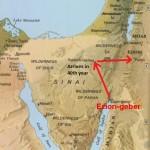
As noted in previous contradictions (see #260-261, #332-334), the Torah preserves variant and contradictory traditions concerning the Israelites’ arrival at Kadedsh, when, from where, for how long, and not least of all how many times. This entry should be seen as part of these variant Kadesh traditions. As noted in contradictions #332-334, Ezion-Geber is the last stop on the itinerary of Numbers 33 before the Israelites arrive at Kadesh, and accordingRead More
#339. Where did Aaron die: Hor OR Moserah? (Num 33:38 vs Deut 10:6)
#340. When did Aaron die: in the 40th year of the wilderness period OR much earlier? (Num 33:38 vs Deut 10:6-7)
After the Israelites arrive at Kadesh for the first and only time according to the itinerary of Numbers 33 (but see contradictions #332-334), they quickly move to mount Hor at the edge of the land of Edom, where it is stated: Aaron died there in the 40th year after the children of Israel came out of the land of Egypt, in the 5th month, on the 1st day of the month.Read More
#341. Do the Israelites conquer Transjordan OR not? (Num 21:21-35; Deut 2:24-3:11 vs Num 33:45-49)
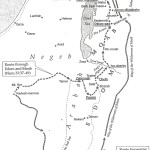
When compared to the earlier itineraries of Numbers 20-21 and Deuteronomy 1-3, the itinerary of Numbers 33 bears witness to a number of discrepancies and contradictions after the Israelites leave mount Hor at the end of the 5th month of the final and last 40th year of the wilderness period (Num 33:39). Many of these contradictions have already been discussed: While Numbers 33:40 (P) merely notes that the Canaanite king ofRead More
#342. Were the Israelites to dispossess the indigenous Canaanites OR utterly destroy them? (Num 33:51-52; Ex 23:28-33 vs Deut 7:1-16)
The itinerary of Numbers 33 ends at verse 49 with the Israelites on the plains of Moab, with no mention of a Transjordanian conquest as previously noted (#341). Here our Priestly author launches into the conquest of the promised land theme, articulated as the very words of Yahweh himself: Speak to the children of Israel and say to them: “When you cross the Jordan to the land of Canaan, you shallRead More
#343. What were the borders of the land of Canaan promised to the patriarchs by Yahweh: from the brook of Egypt to the Euphrates OR from the Red Sea to the Euphrates OR from the Wilderness to Lebo-Hamath OR from Beersheba to Dan (Gen 15:18; Deut 1:7, 11:24; Josh 1:4 vs Ex 23:31 vs Num 34:1-12; Josh 13-19; Ezek 47:13-21 vs Judg 20:1; 1 Sam 3:20; 2 Sam 3:10, 17:11, etc.)?#344. Did Yahweh promise Gilead and Transjordan as part of the promised land OR not (Deut 1-3, 34:1-3 vs Num 34:1-12; Ezek 47:13-20)?

The Bible as it has come down to us preserves a number of varying traditions concerning the size and border of the promised land. Said differently, throughout the roughly six centuries that defined the monarchy, Israel’s exile, and its post-exilic restoration, biblical scribes variously delimited Israel’s borders, often in idealized and utopian ways. This fact the biblical record bears witness to. And Yahweh spoke to Moses: “This is the land thatRead More
#345. A murderer may flee to one of Yahweh’s altars for asylum OR only to one of the cities of refuge (Ex 21:12-14 vs Num 35:11-34; Deut 19:1-13; Josh 20:1-9)?

“You shall make accessible to yourselves towns which will serve you as towns of asylum where a manslayer may flee, one who kills a human being inadvertently. These towns shall serve you as places of asylum from an avenger so the manslayer will not die until he stands before the congregation for judgment.” (Num 35:11-12) There are a number of traditions in the Torah that speak of a manslayer (that isRead More
#346. Does Yahweh establish the cities of refuge for “every murderer” OR for only those who have killed another unintentionally? (Deut 19:4-12 vs Num 35:9-15; Josh 20:2-3)
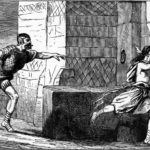
Working from the previous entry (contradiction #345), the Torah, or Hexateuch to include the book of Joshua, speaks of the tradition of asylum in a number of different places. Arranged in roughly chronological order these are: Exodus 21:12-14 from the 9th-8th century Elohist tradition (see #345) Deuteronomy 4:41-43 & 19:1-13 from the 7th century Deuteronomic tradition Numbers 35: 9-28 from the 6th century Priestly tradition Joshua 20:1-9 which looks like aRead More
#347. Does the murderer merely flee to a city of refuge OR must his case first be judged at the gate before admittance? (Deut 19:1-10 vs Num 35:9-18; Josh 20:1-6)
This entry follows the previous two entries (#345 & #346) on the Torah’s variant asylum traditions for murderers. It discusses, once again, a unique feature found only in the Deuteronomic tradition, or shall I say a unique silence or omission. No where does the Deuteronomic tradition (Deut 19:1-13) reference any legal proceedings associated with fleeing to, being admitted entrance in, and residing in a city of refuge. This version of theRead More
#348. A manslayer must remain in the city of refuge until he can stand trial OR until the current high priest dies? (Josh 20:6 vs Num 35:25)
This is the last entry for the book of Numbers. This contradiction continues the previous entries on the Torah’s variant asylum traditions (see Contradictions #345, #346, #347) and seems to be created by a spurious verse embedded in the Joshua passage. That is both the Priestly passage of Numbers 35 and the Priestly redactional work of Joshua 20 state that the murderer who murders another by mistake must remain in theRead More
#349. Does the book of Deuteronomy contain “all the words” that Yahweh spoke to Moses across the Jordan OR not? (Deut 1:1-3 vs Ex 21-31, 34-40; all of Leviticus; Num 1-10, 15, 17:1-20:13, 28-31)
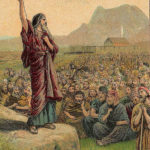
The book of Deuteronomy opens with this seemingly innocuous claim: These are the words which Moses spoke to all of Israel on the other side of the Jordan in the wilderness, in the plains before the Suph (sea), between Paran and Tophel and Laban and Hazeroth and Di-zahab (11 days from Horeb by way of mount Seir up to Kadesh-barnea). And it came to pass in the 40th year in theRead More
#350. After the conquering of Sihon and Og does Moses deliver his first speech OR does Moab hire Balaam, the Israelites commit apostasy at Baal Peor, Yahweh grants the priesthood to Phinehas, Moses and Eleazar take a second census, Yahweh gives laws for the sacrificial calendar, etc… (Deut 1:4-3:29 vs Num 22:1-36:13)
Deuteronomy’s Moses claims that he gives his first speech to the children of Israel, who are assembled before him on the plains of Moab, immediately after the conquest of the kingdoms of Sihon and Og. After he struck Sihon king of the Amorites who lived in Hesbon and Og king of Bashan who lived in Ashtaroth at Edrei on the opposite side of the Jordan in the land of Moab, MosesRead More
#351. After their stay at Horeb, did Yahweh command the Israelites to “Go! Possess the land” OR not? (Deut 1:6-8 vs Num 10:28-36)
Contradictions in the Bible is really a website devoted to textual criticism of the Bible, in particular to what scholars label as source-criticism, that is identifying the Bible’s different and often competing textual sources and assessing when they were written, by whom, to address what historical concerns, in relation to what other literary works, etc. Nearly all of the Bible’s contradictions, from minute narrative inconsistencies to larger theological and ideological agendasRead More
#357. Do the people initiate the plan to send spies to scout out the land OR does Moses command the people to do this? (Deut 1:22 [D] vs Num 13:17 [J])#358. Is the plan to send spies presented as an alternative plan OR Yahweh’s original commandment? (Deut 1:21-22 [D] vs Num 13:1 [P])#359. Are the Amorites in the land OR is it the Canaanites and the Amalekites? (Deut 1:20, 1:27, 1:44 [D] vs Num 13:29, 14:25, 14:43-45 [J])#360. In the face of there being giants in the land, who encourages the people to have faith in Yahweh: Moses OR Caleb OR Caleb and Joshua? (Deut 1:29 [D] vs Num 13:30 [J] vs Num 14:6-9 [P])#361. Does Moses intercede on the people’s behalf exhorting Yahweh not to wipe them out OR does he not? (Num 14:11-23 [J] vs Deut 1:29-40 [D])#362. Is Yahweh also incensed with Moses OR is he not? (Deut 1:37, 3:26 [D] vs Num 14:11-35 [J/P])#363. After the men are defeated at Hormah, do they turn back into the wilderness OR do they return to Kadesh? (Deut 1:40, 2:1 [D]; Num 14:25 [J] vs Deut 1:46 [D]; Num 20:14 [P])
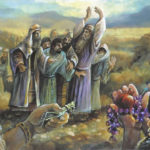
The story of the spying of the promised land is initially recounted in Numbers 13-14, which as we have already seen is a composite text of the Yahwist and later Priestly traditions (see Contradictions #233, #234, #235-236, #237, and #238-240). When we say “composite text,” we mean that the text/story in the form that it has come to us modern readers is composite in nature; it is composed of two onceRead More
#364. Does Yahweh command the Israelites to pass through Edom OR does Moses send messengers to request passage? (Deut 2:2-4 [D] vs Num 20:14-17 [J])#365. When this occurs, are the Israelites wandering about the hill country of Seir OR are they at Kadesh? (Deut 2:1-2 [D] vs Num 20:14 [J])#366. The Edomites are afraid of Israel and thus do not provoke a battle OR they seek them out to fight and it is the Israelites who are afraid? (Deut 2:4-5 [D] vs Num 20:18-21 [J]; Judg 11:16-18)#367. Do the Israelites acquire food and drink from the Edomites OR is this refused? (Deut 2:6-7, 2:28-29 [D] vs Num 20:19-20 [J])#368. Do the Israelites pass through Edom OR are they refused passage and flee? (Deut 2:7-8, 2:28-29 [D]; Num 21:10, 33:41-44 [P] vs Num 20:21 [J])#369. After the Israelites’ encounter with Edom, do they march on toward the wilderness of Moab OR around Moab OR into the Negeb against Hormah? (Deut 2:8 [D]; Num 33:43-44 [P] vs Num 21:12-20 [J] vs Num 21:1-3 [J])

Everyone knows that when the Israelites asked for food and water from the Edomites, the Israelites’ brothers from the line of Esau, and permission to pass through their country they were denied these things and forced to pass around Edom. This story we know from Numbers 20:14-21, which scholars have identified as part of the older southern Yahwist tradition [J]. Yet when Moses renarrates this story some 40 years later, narrativelyRead More
#371. After passing through Edom, did Yahweh speak to Moses about the dispossession of Moab, Edom, and Ammon OR not? (Deut 2:9-23 vs Num 20-21)
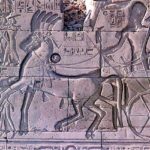
Deuteronomy 2:9-23 is another passage uniquely crafted by the Deuteronomist (see others in Contradictions #349, #350, #351, and #370) and was designed to convey themes and ideological beliefs dear to this 7th century author and his scribal guild. Said differently, and on a textual level, despite “Moses’” insistence that after they passed through Edom—or around Edom or back toward the Red Sea or forward to Hor, depending on which tradition oneRead More
#372. Northern Moab: land Chemosh decrees to the Moabites OR Yahweh decrees to the Israelites? (Num 21:29; Judg 11:24 & the Mesha stele vs Deut 2:24)
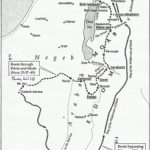
Since I’ve already dealt with the Through-Moab (D) or Around-Moab (J) contradiction in #281, I thought I’d spend some time writing about how scribes of the ancient world legitimated the conquest and ownership of land as well as explained the loss of their land. This was accomplished through the use of a commonly used literary topos or convention, and in our present case both the Bible and the 9th century BCERead More